False Facts About Strawberries You Thought Were True
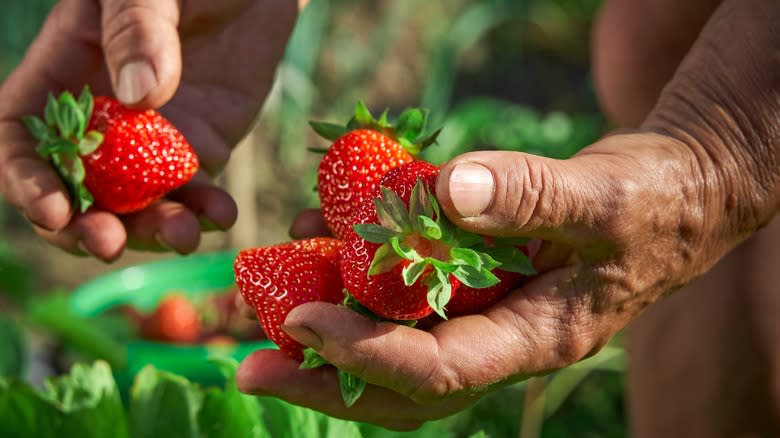
Think you know a lot about strawberries? We have to break it to you: You might believe in quite a few myths about this seemingly simple fruit. For starters, you probably thought that strawberries are "true" berries, but this is the first thing that most people get wrong. By biological definition, strawberries aren't really berries at all. To find out the truth behind misconceptions such as this one, Mashed spoke to two cookbook authors and food bloggers to get insight on the most widespread strawberry myths.
Whether you believe strawberries only come in one variety; think your berries will ripen after you take them home; or assume they're best served cold from the fridge, you're not alone. From myths about the flavor and nutrition of these fruits to the way they should be grown, stored, and served, now's the time to take a closer look at false strawberry facts. Learning the truth just might help you get more enjoyment out of these sweet red gems.
Read more: 7 Nuts You Should Be Eating And 7 You Shouldn't
False: There's Only One Type Of Strawberry
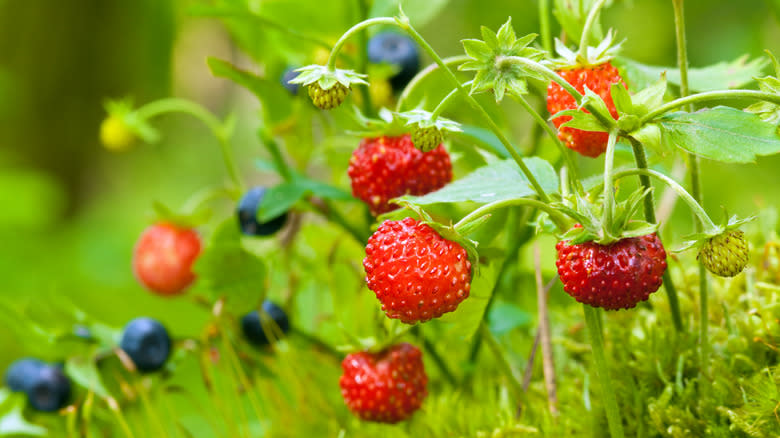
If you've only bought generic strawberries from the grocery store, you might have no idea about the wider strawberry kingdom. "There are more than 600 varieties of strawberries, originating from six original wild species," explains Becky Hardin, founder and recipe expert of The Cookie Rookie. She adds that these breeds can be sorted into larger categories: everbearing strawberries; June-bearing strawberries; and day-neutral strawberries. Within singular species, there are even white strawberries (also called pineberries) and rare premium varieties, one of which costs almost $500 a piece.
Our experts have favorite strawberry varieties that you might be able to find at farmer's markets near you. "Honeoye is a top contender on my list of favorite strawberries," says Hardin. She appreciates their high yield and consistent size. We also spoke to cookbook author and food blogger Lauren Allen of Tastes Better from Scratch. Some of her favorite varieties are Chandler, Camarosa, and Seascape, because "all three offer nice balanced acidity and sweetness."
Let's not forget that there are many wild strawberry breeds, which differ from cultivated varieties in several ways. They are typically smaller in size with a more intense flavor, described as sweeter and more aromatic. They also have a more delicate texture and a shorter shelf life. You might be able to forage for wild strawberries in their native regions, which includes most of the United States.
False: The Sugar In Strawberries Makes Them Unhealthy
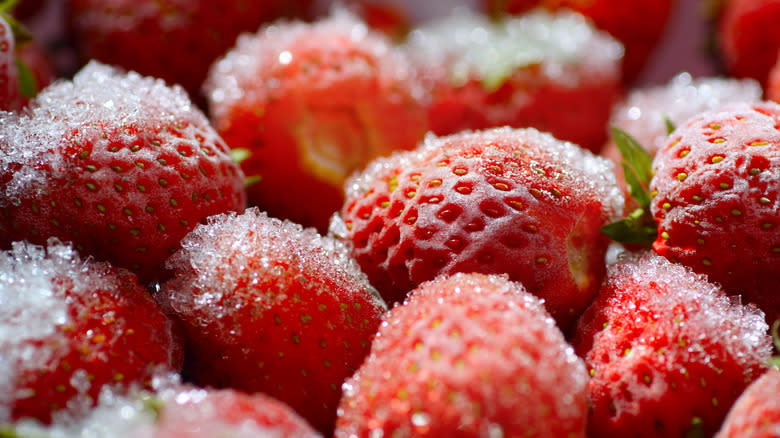
A common misconception is that the sugar in strawberries makes them unhealthy. This isn't necessarily true, as the natural sugars in fruit are better metabolized by your body and are balanced out by other benefits.
Strawberries and other fruits contain all-natural sugars like fructose, glucose, and sucrose. Fructose gives fruits their sweetness, while glucose is easily absorbed by the body and turned into quick energy. Sucrose is simply a combination of fructose and glucose. Most fruits also contain plenty of fiber, which slows sugar absorption, as well as water and nutrients, which not only provide a health boost, but mitigate the sweet stuff to create more balanced blood sugar levels. It's also difficult to eat fruit in such large amounts that its carb content becomes a problem.
What's more, strawberries contain compounds called polyphenols, which improve insulin sensitivity. This can help you to metabolize sugars more effectively and further avoid spikes in blood sugar. In contrast, "free" sugars -- like those added to processed foods and beverages -- come with none of these nutritional benefits. The bottom line: The sugars found in strawberries don't make them unhealthy, and eating them (especially in place of artificial sugar sources) can actually lead to more stable blood sugar levels.
False: You Should Let Strawberries Ripen At Home
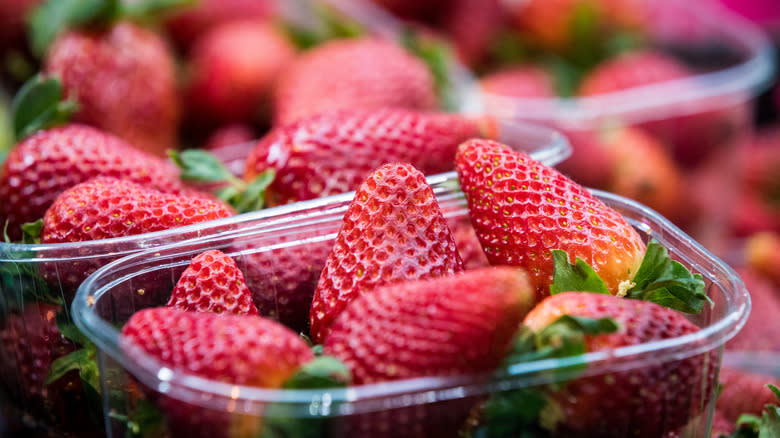
Some people believe that it's best to buy strawberries when they're slightly underripe and let them ripen at home. This seems like a good idea if you don't want to eat them right away, or if you're worried about ripe berries spoiling before you finish them. However, unlike fruits like bananas or avocados, strawberries don't ripen after they've been picked.
Lauren Allen advises shoppers to buy strawberries that already look ripe, or they'll never attain their full sweetness and flavor. The best berries are a vibrant ruby red with a glossy finish, and should feel firm, but yield to gentle pressure. They'll also emit a sweet fragrance, and their green caps should be fully intact and not brown or wilted. However, you also need to make sure you don't buy strawberries that are overripe. "You can tell if strawberries are getting overripe by looking for darker or mushy looking spots," says Allen. "Check the containers carefully because the inside strawberries will usually ripen faster than those on the outside".
False: Strawberries Are True Berries
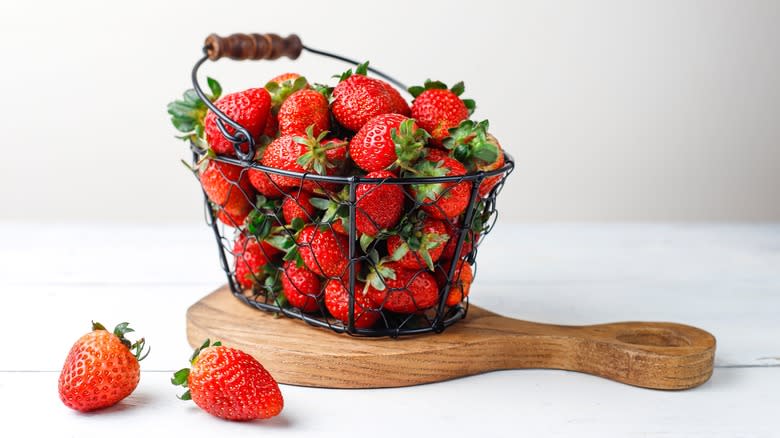
As we mentioned earlier, it's a misconception that strawberries are scientifically classified as berries. Botanically, a berry is a type of fruit that develops from a flower with just one ovary, and typically contains seeds embedded within the flesh. True berries include blueberries and (more surprisingly) tomatoes, grapes, and bananas.
Meanwhile, strawberries come from a flower with multiple ovaries and famously have their seeds on the outside, meaning they're are actually something called an aggregate fruit. Each seed on the exterior of a strawberry is an individual ovary, and the flesh is a swollen receptacle of tissue that holds the seeds. Other examples of aggregate fruits include raspberries and blackberries -- think about how each juicy drupe of these berries holds a single seed. Their composition is more similar to strawberries than you may have thought.
With all of this being said, strawberries are considered berries in the culinary world due to their resemblance to other berries (even if said "berries" are aggregate fruits, too!). The classification of berries is a complicated subject overall, so don't feel the need to think of strawberries any differently (or to start calling tomatoes berries, for that matter).
False: Strawberries Are Only Good In The Spring And Summer
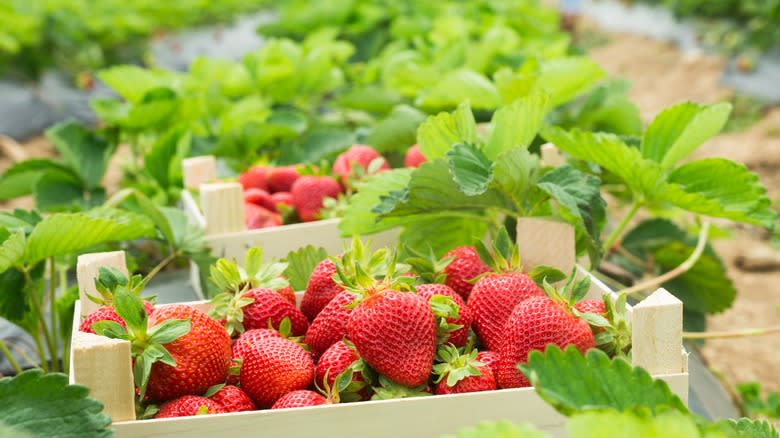
Something you'll often hear about strawberries is that they're only good in the warm months. While there is some truth to this — they're in season in late spring and summer, and are often at their tastiest then — you don't have to avoid strawberries during the rest of the year. According to Lauren Allen, "You can still purchase reasonably good strawberries during other times of the year, but the taste and texture will not compare to just-harvested in-season berries."
Becky Hardin adds that "Strawberries are in season from mid-May to early July in the eastern and midwestern northern [American] states. Winter production occurs in the southern states, such as Florida from late November through early April." Though you can find strawberries in any season, thanks to modern agriculture, Hardin concurs that no berries are as lush as in-season ones. At least if you're in the right place during fall and winter, the berries available to you might be fresher and grown locally, instead of being shipped over.
All of this still doesn't mean that out-of-season berries taste bad, by any means. So long as you carefully choose a box of fresh, ripe berries, it's not a waste of money to buy them in the colder months.
False: Strawberries Are Best Served Cold
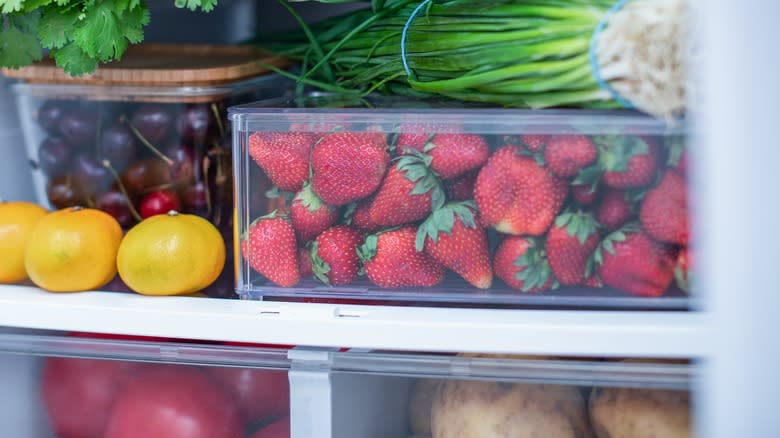
Storing strawberries in the fridge is essential to keeping them fresh, so naturally, most of us serve the berries chilled. However, their flavor becomes stronger when they're served at room temperature, as cold foods tend to have a duller flavor on the tongue. This is the true for many other fruits, including tomatoes, which you should never store in the fridge if you want to enjoy them at their tastiest.
If you plan to eat all your strawberries on the day you buy them, there's no need to refrigerate them at all. If you do put them in the fridge, just be sure to take them out and bring them up to room temperature before serving. Becky Hardin recommends letting the berries sit out for an hour or two, though smaller quantities of berries will warm up faster. With just a little patience, you can enjoy strawberries at their most flavorful.
False: Strawberries Are High In Vitamin C But Not Much Else
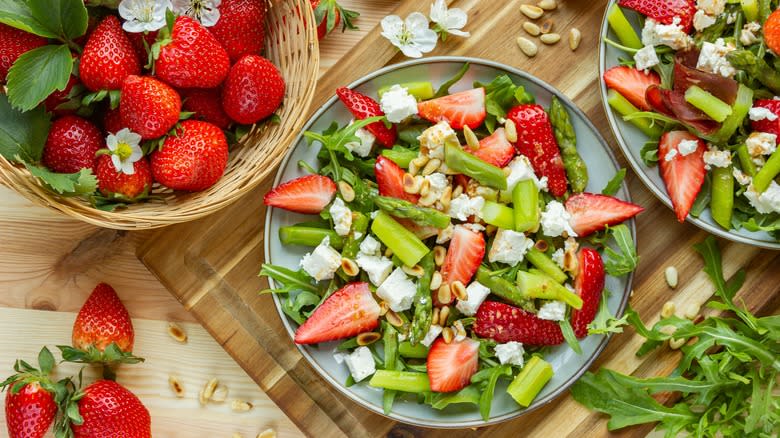
Most people know that strawberries are rich in vitamin C; in fact, one cup contains around 150% of your recommended daily amount. What you might not know is that these little fruits contain a huge list of other nutrients. These may not be present in such vast quantities as vitamin C, but these berries ought to get more credit for them.
Other nutrients in strawberries include manganese (which can benefit your bones and immune system), folate (which is vital for cell function and tissue growth), and potassium (which is crucial for maintaining proper heart function, regulating blood pressure, and supporting muscle and nerve function). Strawberries also contain smaller quantities of vitamins B6, K, and E; magnesium, iron, phosphorus, and copper.
Strawberries also contain various antioxidants, such as anthocyanins and flavonoids, which help protect the body against oxidative stress and inflammation, reducing your risk of chronic diseases like heart disease and cancer. Plus, they're a good source of dietary fiber, which helps to promote digestive health. Overall, there are plenty of reasons to eat strawberries beyond their plentiful vitamin C.
False: There's No Such Thing As Eating Too Many Strawberries
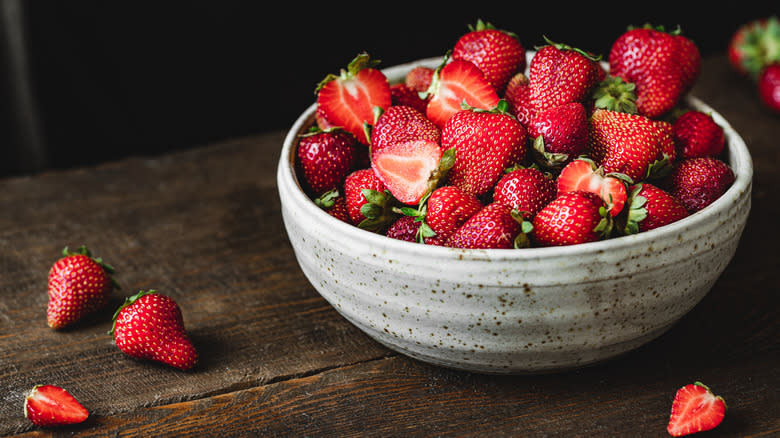
There's no doubt that strawberries are healthy for you, but as with most foods, you can have too much of a good thing. It is, in fact, possible to eat too many strawberries. While the natural sugars and fiber in these berries are good for you in moderation, consuming excessive amounts can lead to digestive discomfort. Eating too many strawberries may lead to stomach pain, bloating, diarrhea, or gas. These are actually common risks of overindulging in any kind of fruit.
One serving of strawberries is around one cup, or eight berries. Most people can probably eat two to three servings a day without experiencing any unwanted symptoms, but everyone's body is different. You could probably eat a lot of strawberries now and again without getting any gastrointestinal side effects, but reach for yet another box, and you might be in trouble.
False: Strawberries Are Hard To Grow
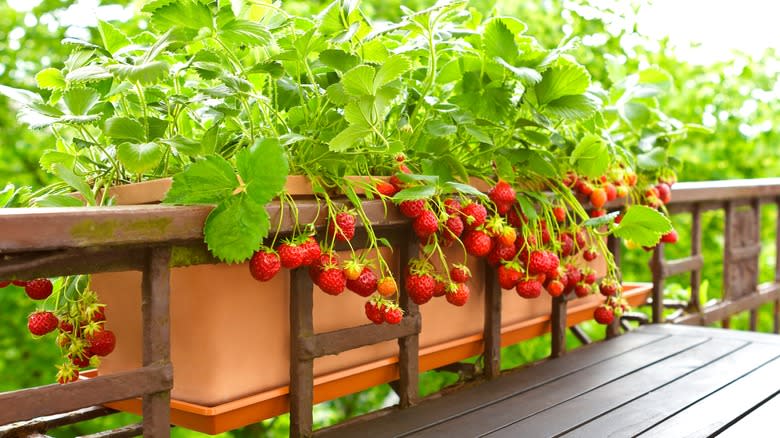
Have you considered growing your own strawberries, but heard that they're hard to cultivate? Our experts beg to differ. "While strawberries require specific conditions to thrive, they are generally not considered difficult to grow," says Becky Hardin. She notes that different varieties suit different climates, so you can find specific strawberry plants that will grow well where you live.
You will need some outdoor space to grow the berries, but they can thrive in smaller beds or in containers. Even if you just have a smaller balcony or a patio, chances are you can fit in some strawberry plants. According to Hardin, what's really important is paying proper attention to soil, water, and sunlight requirements. It's also worth noting that the first year's yield will be minimal. It isn't until the second year that your strawberry plants will really come into their own, so be patient and you'll be rewarded with a bigger harvest.
One of the many great things about growing your own strawberries is that you can plant heirloom types that you're less likely to find in a grocery store. Raising your own plants is an easy way to sample some of our experts' favorite varieties.
False: Bigger Strawberries Are Tastier
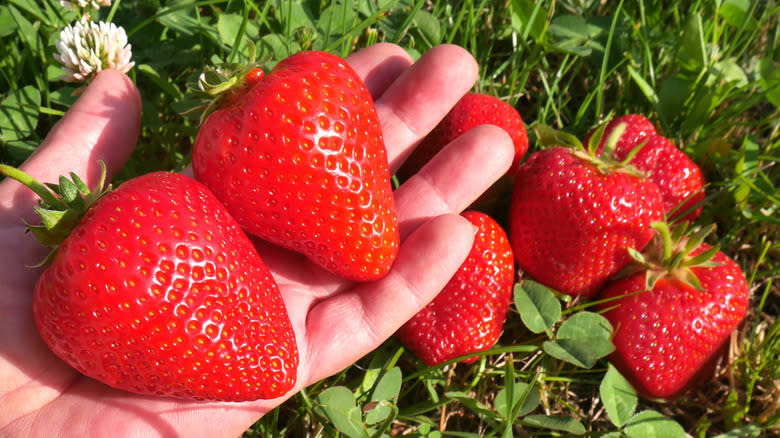
Huge strawberries may look more alluring than tinier ones, but don't be fooled by appearances. "Berry size does not impact flavor," notes Lauren Allen. "The flavor comes more from the ripeness and variety than the size." Thus, bigger berries aren't always sweeter and tastier than smaller ones, or vice-versa. You're often going to find both larger and smaller berries in a single box or patch, and it's better to inspect their ripeness to judge their taste.
Look for berries that are fragrant, ruby-red, and perfectly ripe, and leave ones that still have whitish or greenish parts on the plant, even if they look large and fully-grown. This way, you'll have a tasty harvest on your hands. And even if you notice that bigger berries from your garden taste better than smaller ones, things might be completely different from harvest to harvest, which is why size isn't the most reliable indicator.
False: You Should Always Eat Strawberries Raw

Some people believe that you should always eat strawberries raw if you want to enjoy them at their best. While it can seem like a waste to cook the best spring or summer strawberries, berry lovers should also treat themselves to luscious strawberry recipes. You can always cook with them when they're out of season, or when you get a slightly sour batch that could be improved with just a little sugar.
There are all kinds of strawberry dessert recipes you can try, from jams to ice cream to parfaits, and even some savory ways to enjoy them, like adding them to a summer salsa. "One of my go-to strawberry recipes is a classic vanilla cake with strawberry filling," says Becky Hardin. She enjoys serving it as a beautiful dessert centerpiece, and you can either use fresh berries or cook slightly tart ones into a compote or jam. Hardin also loves classic strawberry lemonade and a strawberry shortcake pie "with layers of strawberries, cream, and pound cake".
False: You Should Wash Strawberries Before Storing Them
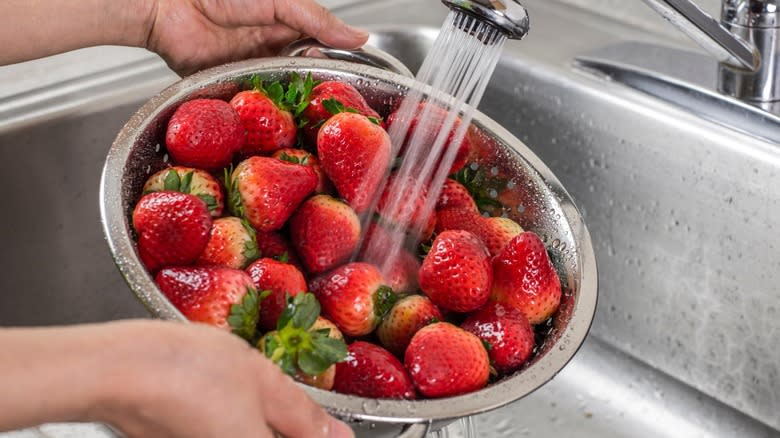
Say you've chosen the best strawberries from the store, and now you're taking them home to eat over the course of the week. You might want to wash off any dirt, bacteria, and other nasties before you store them in the fridge, but this isn't the right call if you want them to last as long as possible. "Once you wash the strawberries and add in that moisture they will mold and get mushy much faster," Lauren Allen explains.
How should you store your strawberries to keep them fresh for longer? Allen recommends placing unwashed berries in an open container lined with a paper towel. Becky Hardin agrees, adding that you want to arrange the berries in a single layer, if you can. "You can also store them unwashed in a mason jar," says Allen. "The airtight container helps them stay fresher longer." Hardin notes that properly-stored strawberries will keep fresh in the fridge for around a week. However, this can vary depending on how ripe they were when you bought them and how much time they spent at room temperature, so check on your strawberries daily and remove any mushy or moldy specimens.
Read the original article on Mashed


